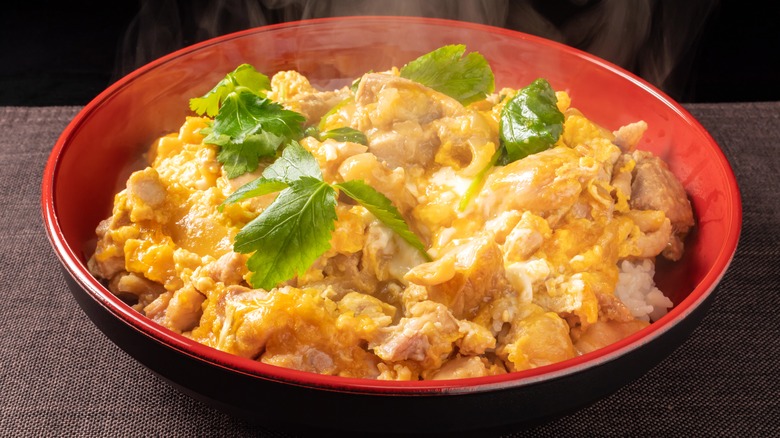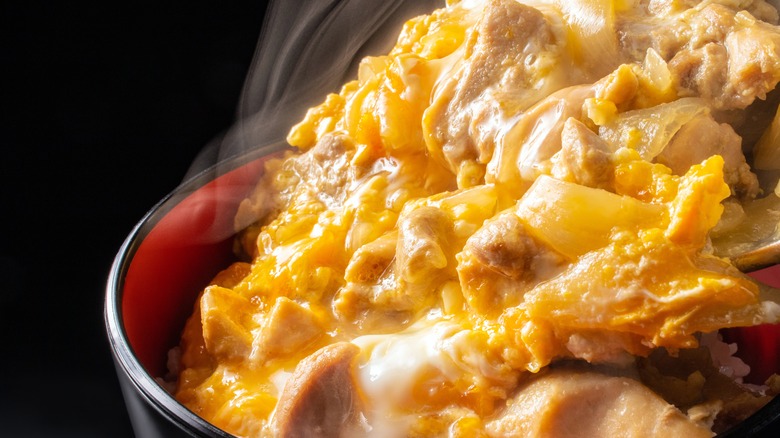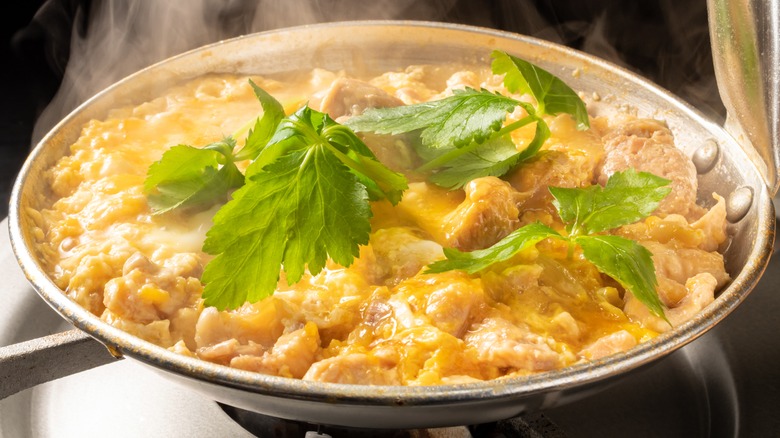Oyakodon Is Chicken And Eggs With A Side Of Poetry
"Oyakodon" — literally "mother and child rice bowl" in Japanese — is one of the most popular dishes in Japan, served by home cooks and fast-food restaurants alike. As part of the donburi — rice bowls in Japan — family of the country's cuisine, the poetic name alludes to the main ingredients of the topping that covers the rice underneath, a simmered mix of chicken and eggs accented by onions and dashi broth.
The dish was created in 1891 by the restaurant Tamahide, an institution first opened for business in the 18th century. It has since become a universally beloved dish, both as part of Japanese home cooking and for quick lunches for workers during the day. Oyakodon is so ubiquitous that learning how to make it is part of the home economics curriculum in schools.
In addition to being simple to make, oyakodon is also delicious and healthy. Soy sauce and dashi both have plenty of umami, and onions and mirin provide a hint of sweetness. Since it is a simmered dish, oyakodon is low in fat, while the chicken and egg have plenty of protein.
Making an oyakodon
To make an oyakodon, you will need boneless and skinless chicken thighs, eggs, onions, dashi broth, soy sauce, and mirin, which is Japanese cooking sake. You can substitute mirin with a mix of dry sake and sugar, and leeks and spring onions for onions. However, chicken breasts cannot substitute for chicken thighs, as breast meat overcooks easily and quickly. Optionally, you can include vegetables such as bamboo shoots and shiitake mushrooms in the mix. For those who wish to refrain from meat, you can use firm-pressed tofu instead.
Prepare the ingredients by slicing the onions into half rounds. If you are using leeks, clean them thoroughly and slice them into one-inch-long rounds. Slice the chicken thighs and the optional vegetables into bite-sized pieces. Meanwhile, prepare some dashi from scratch by steeping kombu seaweed and katsuobushi, a type of Japanese dried fish, in simmering water. Alternatively, create one using instant dashi powder, which you can purchase from Asian markets or online.
Mix mirin, soy sauce and dashi, and pour the mixture into a pan. Traditionally oyakodon is made with a specially designed pan that looks like a small frying pan with a vertical handle, but you can simply use a small frying pan. Turn the heat to medium and bring the liquid to a simmer. Add the onions and cook for a minute, followed by the chicken pieces and the optional vegetables.
Finish the oyakodon with eggs
Meanwhile, whisk the eggs briefly until the yolks are broken but not homogenized. Once the chicken is about halfway done, pour two-thirds of the mixture into the pan, taking care to distribute it evenly. Let the mixture simmer as the eggs thicken. When the chicken is almost done cooking and the eggs look semi-solidified, pour the rest of the egg on top and let it cook briefly. Slide the entire mixture on top of a bowl of rice. the eggs should still be soft, giving the dish a luscious texture. Garnish with sliced scallions and serve with Japanese pickles.
To properly enjoy an oyakodon, start by digging to the bottom of the bowl so the rice absorbs the eggs and sauce evenly. To spice up your oyakodon, season your bowl with Japanese shichimi chili powder for an authentic experience.
If you plan on making a large batch to save meal prep time over the week, you can complete every step except adding the egg in a larger saucepan. When you are ready to make individual servings, heat each portion in a small frying pan until simmering before adding the egg in two steps mentioned above. Aside from steamed rice, the mixture is also delicious served with boiled udon noodles.



